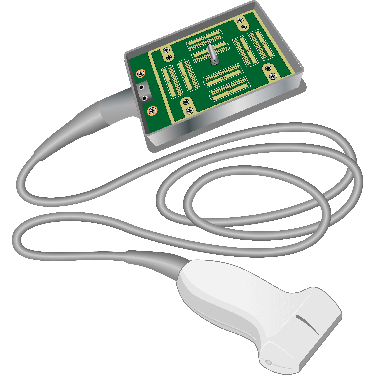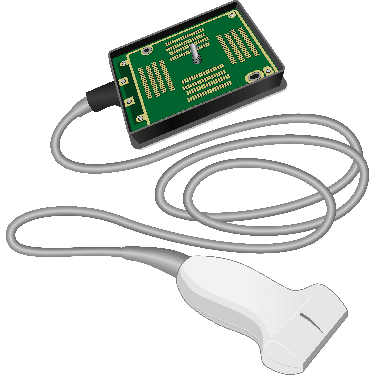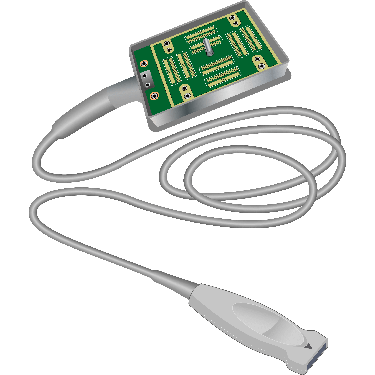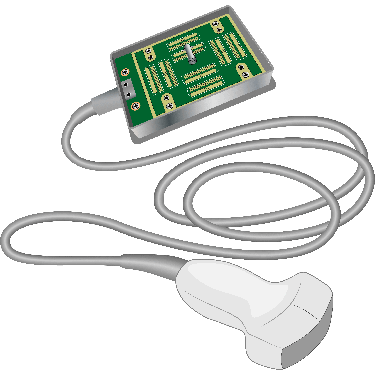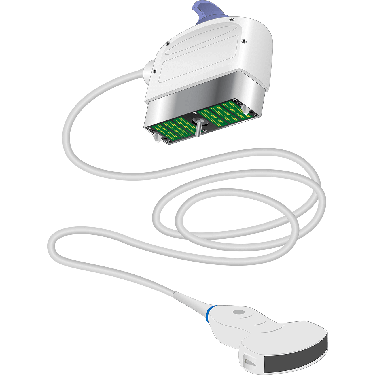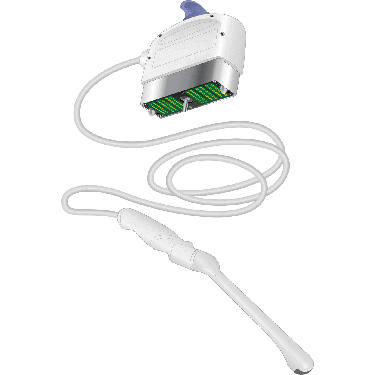Various models of ultrasound probes are available, and purchasing from a leading brand ensures not only its durability but also optimal performance and accuracy in the long term. Established brands like GE Healthcare, Philips, Fujifilm SonoSite, Toshiba, Samsung Healthcare, Siemens Healthineers, Kontron, BK Medical, Canon Medical and Esaote are known for their advanced features, such as enhanced imaging resolution, ergonomic designs, and after-sale services.
At Elzhen, we offer a wide range of probes from leading brands, allowing you to select the best one that meets your medical needs. Please fill out this form for orders or any specific inquiries; we will gladly assist you.
Ultrasound Probes
Buy a New Ultrasound Transducer
The first step in purchasing a new ultrasound transducer or probe is to identify the right type based on your medical and clinical requirements. Various ultrasound transducers, such as linear, convex, endocavitary, pencil, and transesophageal echocardiography (TEE), are available in different models, each offering unique features. At elzhen, we recommend consulting our professionals, who are experts in ultrasound equipment and technology. Clearly outline your clinical and medical requirements, and they will assist you throughout the purchasing process, ensuring you get the best price and free delivery.

Top Probes
We’ve proudly worked with many companies, and here are some of our most popular probes available at the best prices.
Whether you're looking to purchase brand-new ultrasound transducers or need high-quality repaired ones, you've come to the right place!
For advice, consultation, purchase, or repair services, feel free to visit Elzhen; we’re here to help with all your ultrasound probe needs.
- Refurbished Fujifilm Sonosite HFL38xi Linear Array Probe
$3,100.00USD
Refurbished
In Stock
- Refurbished Fujifilm Sonosite HFL38xp Linear Array Probe
$4,000.00USD
Refurbished
In Stock
- Refurbished Fujifilm Sonosite L25x Linear Array Probe
$2,800.00USD
Refurbished
In Stock
- Refurbished Fujifilm Sonosite rC60xi Convex Array Probe
$3,200.00USD
Refurbished
In Stock
- Refurbished GE Healthcare C1-6-D Convex Array Probe
$3,500.00USD
Refurbished
In Stock
- Refurbished GE Healthcare IC5-9-D Micro Convex Array Probe
$2,645.00USD
Refurbished
In Stock
Discover Our Best-Selling Models From Leading Brands


Need an Ultrasound Transducer?

An ultrasound probe is a critical component of any ultrasound system, and selecting the right one is essential for accurate diagnostic imaging. But how do you make the best choice while ensuring you get the best price and after-sales services? With various types of probes available and each designed for specific imaging needs, should you invest in a new model or opt for a used and repaired one?
At Elzhen, we'll answer all these questions. We are committed to providing the most up-to-date information and expert advice to ensure a seamless experience when purchasing a probe. Contact us now for any further information.
Transducers Repair Service
Ultrasound transducers (or probes) can face damage over time due to regular use, improper handling, chemical exposure, heat, and moisture. As they have a crucial role in accurate medical imaging, even small issues or minor damage to the probes can result in incorrect or incomplete images, which could affect medical results. Therefore, any damage to the probes should be addressed and repaired as soon as possible. At Elzhen, our expert team provides efficient, cost-effective probe repair solutions, ensuring your probes perform well. Contact Elzhen today for high-quality repair services at the most competitive prices.

Our Trusted Clients
Trusted by over 600 hospitals, universities, and clinics, we offer a variety of ultrasound probe services. Whether you’re looking for brand-new transducers or high-quality repairs, we’re proud to be your choice. Visit Elzhen to explore our range of products designed to fulfill your medical needs.
Get a Free Quote
Transducer Blog
How to Use Ultrasound Probe?
First, connect the ultrasound probe to the ultrasound machine using a connector. Depending on your medical needs, you can use different types of probes, such as linear, convex, etc. You need to position the patient appropriately based on the examination area, use the gel on the patient’s skin over the examined area, and move the probe around the area to capture the images from inside the body.
What Does an Ultrasound Transducer Monitor?
Ultrasound transducers are widely used in medical imaging to produce images of the inside of a patient’s body. This is done with the help of piezoelectric crystals, the main component of the transducer, which generate and receive sound waves. Different types of probes are used to capture images from various areas, including internal organs (e.g., liver, kidneys, heart), fetal development during pregnancy, blood flow through Doppler ultrasound, tissues and muscles, etc. For example, to examine the abdomen and provide a picture from inside of it, we can use a curvilinear (or convex) transducer, which is designed with a wide field of view due to its curved surface.
What is the Best Type of Ultrasound Probe?
With different ultrasound probe types and uses, there is no definite answer for choosing the best one; it highly depends on your medical and clinical requirements. For instance, curvilinear probes are ideal for deep abdominal scans, while linear probes provide high-resolution imaging for superficial structures like blood vessels and muscles. Phased array probes are essential for cardiac examinations due to their small footprint, allowing access between ribs.
How Is the Ultrasound Probe Frequency?
There is a wide range of ultrasound probes, each with its own unique features and key characteristics. Probes that produce higher-resolution images typically operate at higher frequencies, making them ideal for superficial structures. On the other hand, probes designed for deeper imaging operate at lower frequencies, offering greater penetration but with lower image resolution.
What Are the Various Ultrasound Probe Types?
The most widely used ultrasound probes include the linear probe, curvilinear (convex) probe, phased array probe, endocavitary probe, 3D/4D probes, TEE (Transesophageal Echocardiography) probe, and pencil probe (continuous wave doppler).
Each of these ultrasound transducers can differ from one another based on various features such as frequency, shape, design, crystal arrangement, and footprint. These differences influence the probe's ability to capture images with specific depth, resolution, and field of view.
FAQs
How Does a Transducer Work in Ultrasound?
Why Is Gel Used Between the Transducer and the Patient’s Skin?
How to Mount a Transducer?
